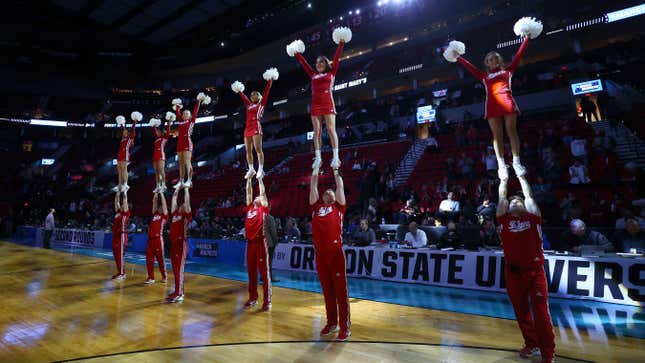College Cheerleaders Deserve Our Attention. They’re Getting It for the Wrong Reasons.
The mostly-women athletes, who rarely get face time during televised events, are suddenly dominating March Madness discourse--but not for their talent.
In Depth

Cassidy Cerny, a 20-year-old sophomore at Indiana University, didn’t think what happened last week during the Hoosiers’ March Madness men’s basketball game was all that remarkable.
After the game ball got stuck at the top of the backboard and was out of reach for even the teams’ tallest players, Cerny was hoisted atop her cheer teammate’s hands and carried over to the net. She easily plucked the ball out, and the arena burst into cheers. It wasn’t until Cerny got home and watched the gamecast that she realized the announcer had screamed on air, “THE CHEERLEADER SAVES THE DAY…WHAT A SHINING MOMENT!!!”
Since then, aside from going viral and landing an interview on The Today Show, Cerny has inked a name, image and likeness (NIL) deal with apparel company Breaking T, which designed a commemorative t-shirt in her honor. In a phone interview with Jezebel on Thursday, Cerny said that she and Paris are excited and “overwhelmed” to have received “nonstop” pitches from companies hoping to partner with them—something that simply does not happen for gameday college cheerleaders.
But Cerny is still wrapping her head around the fact that so many people, including an NCAA tournament broadcaster, had named her an unlikely hero over a relatively basic cheerleading skill in the first place. “Once I realized how big it had gotten, it definitely was like, ‘Wow, people are actually impressed by this?’” she said. “It’s crazy because that hands extension is something that we do every single day. It’s not a big deal to us, but seeing it out of context and actually having everyone pay attention to what we’re doing was insane.”
It should not be “insane” for an audience as large as March Madness’, which is reportedly averaging 9.1 million viewers per day, to notice the women-dominated cheer and dance teams who have loyally graced sidelines for decades. And yet, a mere glimmer of what these college athletes are really capable of has sent brands and viewers spiraling in a tizzy, seemingly shocked that the cheerleaders, often working entirely in support of their fellow university athletes, are actually talented…and useful, at that. The explosion of excitement now being extended to Cerny and her cheerleading teammates is, of course, heartwarming beyond belief. But it also lays bare the widespread invisibility of cheerleaders—some of the most under-resourced, under-utilized, and under-celebrated collegiate athletes in America—which can often manifest in ugly and dangerous ways.
-

-

-

-

-

-

-

-

-

-

-

-

-

-

-

-

-

-

-

-

-

-

-

-

-

-

-

-

-

-

-

-

-

-

-

-

-

-

-

-








































